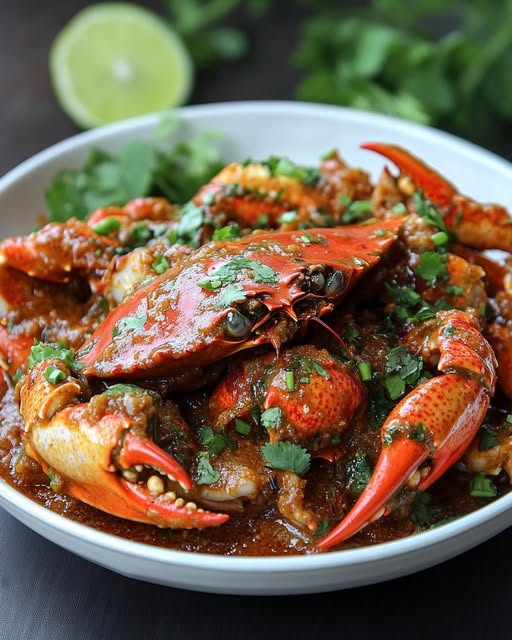Why Singapore Chili Crab Will Make Your Taste Buds Dance
Picture this: a cozy dinner with friends, laughter filling the room, and the smell of something truly magical wafting from the kitchen. That’s exactly what happened when I first made **Singapore Chili Crab**. This dish is not just food; it’s an experience. The juicy crab meat coated in a rich, spicy-sweet sauce is like a party in your mouth. And let me tell you, once you try it, you’ll understand why it’s one of Singapore’s most beloved dishes. Whether you’re new to cooking seafood or a seasoned pro, this recipe will make you feel like a culinary rockstar.
The Story Behind Singapore Chili Crab
Singapore Chili Crab was born in the 1950s, thanks to a street hawker named Cher Yam Tian. She started by stir-frying mud crabs with bottled chili sauce, and soon her creation became a local favorite. Over time, chefs refined the recipe, adding ingredients like ketchup and egg to create the glossy, tangy sauce we know today. It’s now a national treasure, served everywhere from humble hawker stalls to high-end restaurants. When I made it for my family, they couldn’t believe how authentic it tasted. “Is this really homemade?” they asked. Yes, yes it is!
Why You’ll Love This Recipe
This **Singapore Chili Crab** recipe checks all the boxes: bold flavors, simple steps, and a touch of elegance. The sauce is the star—spicy, sweet, and slightly tangy, with a velvety texture thanks to the beaten egg. Plus, working with fresh crab feels indulgent but isn’t as intimidating as you might think. Trust me, even if you’ve never cooked crab before, this dish will turn out amazing. And the best part? It’s perfect for sharing. Food always tastes better when enjoyed with loved ones, right?
Perfect Occasions to Whip Up This Dish
Whether you’re hosting a dinner party, celebrating a special occasion, or just craving a taste of Southeast Asia, **Singapore Chili Crab** fits the bill. It’s ideal for impressing guests because it looks fancy but doesn’t require hours of prep. I love making it for birthdays or holidays—it’s a showstopper that gets people talking. Pair it with steamed buns or white rice, and you’ve got yourself a feast fit for royalty.
Ingredients You’ll Need
- For the spice paste:
- 2 medium onions or 10 shallots
- 10 garlic cloves
- 5 cm fresh ginger
- 5 dried red chilies, soaked in hot water for 10 minutes
- For the crab:
- 2 fresh crabs, cleaned and cut into pieces
- 2 tablespoons peanut oil
- 2 tablespoons soy sauce
- 2 tablespoons chili sauce
- 2 tablespoons ketchup
- 1 tablespoon sugar
- 1 teaspoon salt
- 1 tablespoon rice vinegar
- 1 cup chicken broth
- 1 tablespoon cornstarch mixed with ½ cup water
- 1 egg, beaten
- Chopped green onions and fresh cilantro for garnish
Substitution Options
If you can’t find fresh crabs, frozen crab legs work too. Swap peanut oil with vegetable oil if needed. For a milder version, use fewer dried chilies or opt for mild chili sauce. Don’t have rice vinegar? Lemon juice is a great alternative. And if you’re out of cilantro, parsley adds a fresh touch. Flexibility is key here—make it yours!
Step 1: Prepare the Spice Paste
Let’s start by making the heart of this dish—the spice paste. Grab your blender and toss in the onions, garlic, ginger, and soaked dried chilies. Blend until smooth. The aroma alone will transport you straight to a bustling Singapore market. Pro tip: If your blender struggles, add a splash of water to help it along. Once done, take a moment to admire the vibrant red-orange paste—it’s the foundation of your flavor bomb.
Step 2: Cook the Spice Paste
Heat the peanut oil in a wok or large skillet over medium heat. Add the spice paste and let it sizzle away for 5-7 minutes. Stir frequently to prevent burning. As the paste cooks, you’ll notice the oil separating—a sign that it’s ready. This step intensifies the flavors, so don’t rush it. Imagine the wok whispering secrets of Singaporean kitchens as the fragrance fills your home.
Step 3: Add Sauces and Seasonings
Now comes the fun part: building the sauce. Stir in the soy sauce, chili sauce, ketchup, sugar, salt, and rice vinegar. Mix well and let it simmer for 2 minutes. The colors will deepen, and the scent will make your stomach growl. Pro tip: Taste as you go. Adjust the sweetness or spiciness based on your preference. Remember, cooking is personal!
Step 4: Cook the Crab
Add the crab pieces to the sauce, ensuring each piece is generously coated. Pour in the chicken broth, cover, and let it simmer for 10-15 minutes. Watch as the crab turns a gorgeous reddish hue, signaling it’s cooked through. The steam rising from the wok carries hints of spice and sweetness—a promise of deliciousness ahead.
Step 5: Thicken the Sauce
To achieve that signature glossy texture, stir in the cornstarch mixture. Keep whisking to avoid lumps. Within moments, the sauce thickens, clinging lovingly to the crab. It’s like watching magic happen right before your eyes. Chef’s tip: For extra silkiness, drizzle in the beaten egg slowly while stirring continuously. Voilà—you’ve got ribbons of golden goodness!
Step 6: Garnish and Serve
Sprinkle chopped green onions and fresh cilantro over the top for a pop of color and freshness. Serve piping hot alongside fluffy white rice or crispy mantou buns. Watching everyone dig in is pure joy. Their faces light up with every bite, and suddenly, your kitchen feels like the happiest place on earth.
Timing Breakdown
- Preparation time: 20 minutes
- Cooking time: 30 minutes
- Total time: 50 minutes
This quick yet impressive timeline makes it perfect for busy weeknights or last-minute gatherings.
Chef’s Secret
Here’s a little trick I learned: crack the crab shells slightly before cooking. This allows the flavorful sauce to seep into the meat, enhancing every bite. Trust me, it makes a world of difference.
An Interesting Tidbit
Did you know that Singaporeans often eat chili crab with their hands? It’s messy but oh-so-fun. Embrace the chaos—it’s part of the charm!
Necessary Equipment
- A sturdy wok or large skillet
- A blender or food processor
- A wooden spoon for stirring
- A sharp knife for prepping ingredients
Storage Tips
If you have leftovers (unlikely, but possible), store them in an airtight container in the fridge. The flavors meld beautifully overnight, making it taste even better the next day. Reheat gently on the stovetop, adding a splash of water to loosen the sauce. Avoid microwaving, as it can dry out the crab meat.
For longer storage, freeze portions in freezer-safe bags. Just thaw overnight in the fridge before reheating. Note that the texture may change slightly after freezing, but the taste remains divine.
Never refreeze thawed crab, as it compromises both safety and quality. Always plan ahead and enjoy responsibly.
Tips and Advice
- Use fresh ingredients whenever possible—they make a noticeable difference.
- Patience is key when cooking the spice paste. Let it develop its full potential.
- Don’t skimp on the garnishes. They add brightness and balance to the dish.
Presentation Ideas
- Serve in a large communal platter for a wow factor.
- Arrange crispy fried mantou buns around the edges for contrast.
- Add edible flowers for a touch of elegance.
Healthier Alternatives
Want to lighten things up? Try these variations:
- Baked Version: Roast the crab instead of frying for less oil.
- Low-Sodium Option: Use reduced-sodium soy sauce and omit added salt.
- Vegan Twist: Replace crab with tofu or jackfruit.
- Gluten-Free: Swap regular soy sauce with tamari.
- Less Spicy: Reduce the number of chilies or use bell peppers for color.
- Herbaceous Touch: Add Thai basil for a fragrant twist.
Mistake 1: Overcooking the Crab
Overcooked crab becomes tough and rubbery, ruining the delicate texture. To avoid this, keep an eye on the cooking time and remove the crab as soon as it turns opaque. Practical tip: Test one piece for doneness before proceeding.
Mistake 2: Skipping the Spice Paste
The spice paste is non-negotiable—it’s the soul of the dish. Some skip it to save time, but trust me, it’s worth the effort. Without it, the flavors fall flat.
Mistake 3: Not Balancing Flavors
This dish thrives on balance. Too much sweetness or spiciness can overpower the crab. Taste as you cook and adjust accordingly.
Frequently Asked Questions
Can I use canned crab meat?
While fresh crab is ideal, canned crab works in a pinch. Drain it well and add it towards the end to heat through without overcooking.
What type of crab should I use?
Blue swimmer crabs are traditional, but Dungeness or snow crabs are excellent substitutes. Choose what’s freshest at your local market.
How do I clean a live crab?
Place the crab in the freezer for 15 minutes to sedate it. Then scrub under running water, remove the shell, and rinse thoroughly. Wear gloves for safety.
Can I make this dish ahead?
You can prep the spice paste in advance and refrigerate it for up to 2 days. However, cook the crab fresh for optimal taste and texture.
Is this dish very spicy?
It has a kick, but you can adjust the spice level by reducing the chilies or using milder sauces. Tailor it to your heat tolerance.
Where can I buy mantou buns?
Check Asian grocery stores or online retailers. They’re also easy to make at home with a simple dough recipe.
Can I double the recipe?
Absolutely! Just ensure your wok is large enough to accommodate the increased volume. Adjust seasoning gradually.
What’s the best side dish?
Steamed jasmine rice or crispy fried mantou buns complement the dish perfectly. A cucumber salad adds refreshing contrast.
How do I reheat leftovers?
Gently warm on the stovetop with a splash of water. Avoid microwaving to preserve the crab’s texture.
Can kids enjoy this dish?
Yes, if you tone down the spice. Kids usually love the sweet-tangy sauce. Serve with plain rice to balance the flavors.
There you have it—everything you need to conquer **Singapore Chili Crab** in your own kitchen. From its rich history to practical tips and creative twists, this guide ensures success. So grab those crabs, fire up the stove, and get ready to create a meal that’s equal parts comforting and exotic. Happy cooking!

Singapore Chili Crab
Ingredients
Equipment
Method
- Prepare the spice paste by blending onions, garlic, ginger, and soaked chilies until smooth.
- Cook the spice paste in a heated wok with peanut oil for 5-7 minutes until fragrant.
- Add soy sauce, chili sauce, ketchup, sugar, salt, and rice vinegar; simmer for 2 minutes.
- Add crab pieces to the sauce, pour in chicken broth, cover, and simmer for 10-15 minutes.
- Stir in the cornstarch mixture to thicken the sauce, then add the beaten egg while stirring.
- Garnish with green onions and cilantro; serve with white rice or mantou buns.
